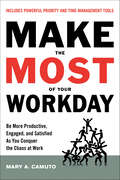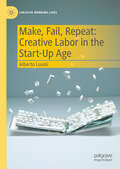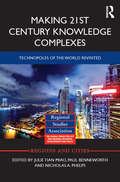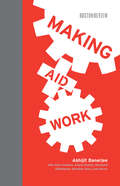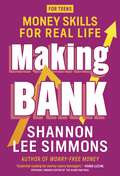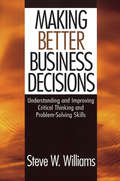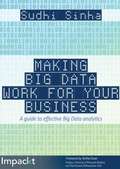- Table View
- List View
Make the Decision: Getting to Agreement
by Richard LueckeComplex decisions inevitably have unresolved uncertainties that are bound to trouble some decision makers. This chapter outlines three techniques--catchball, point-counterpoint, and intellectual watchdog--to help decision makers maneuver these difficulties. Although these techniques cannot guarantee a decision team will agree on one decision, they will help them agree on a collective objective.
Make the Impossible Possible
by Vince Rause Bill Strickland“Success is the point where your most authentic talents, passion, values, and experiences intersect with the chance to contribute to some greater good. ” --Bill Strickland According to MacArthur Fellowship “genius” award winner Bill Strickland, a successful life is not something you simply pursue, it is something that you create, moment by moment. It is a realization Strickland first came to when, as a poor kid growing up in a rough neighborhood of Pittsburgh, he encountered a high school ceramics teac...
Make the Most of Your Workday: Be More Productive, Engaged, and Satisfied As You Conquer the Chaos at Work
by Mary CamutoEven if you don't have your dream job, every day is precious and filled with opportunities. Make the Most of Your Workday challenges you to actively manage and make the most of workday possibilities and problems. With drive, determination, and optimism, it offers solutions to workday predicaments. You can take control; you don't have to wait for leaders, people, or circumstances to change. No matter your level, situation, or dilemma, Mary shows you how to regroup, reframe, and bounce back.Make the Most of Your Workday begins with six common scenarios. Can you relate to any of the following challenges? •Getting caught up in office dramas.•Watching workloads increase while resources decrease.•Feeling your interest, enthusiasm, and focus fade.•Yearning for effective leadership.•Wanting to avoid working with certain people.•Feeling at the mercy of technology.Make the Most of Your Workday contains powerful strategies and tools from several key areas and combines them into a concise practical guide, from strengthening your mindset and self-awareness to identifying needs and goals, from prioritizing your time and energy to communicating effectively and managing the unexpected.
Make the Rules or Your Rivals Will
by G. Richard ShellTHERE IS A NEW TRUTH ABOUT BUSINESS STRATEGY: HE WHO MAKES THE RULES MAKES THE MONEY A few savvy executives understand a vital but hidden truth about business in fiercely competitive markets: Making the rules of the game means the difference between winning and losing. • Bill Gates has known this since he was nineteen, when he personally drafted his first licensing contract for a start-up company called Microsoft. • Henry Ford learned it the hard way in the early days of the automobile industry when ...
Make the World a Better Place: Design with Passion, Purpose, and Values
by Robert KozmaMAKE THE WORLD A BETTER PLACE “This book is a must read for all with an interest in the future of design.” —Jim Spohrer, PhD, Retired Industry executive, International Society of Service Innovation Professionals “The world is in need of better design, and Kozma’s book shows us how to get there.” —Mark Guzdial, Director, Program in Computing for the Arts and Sciences, College of Literature, Science, and the Arts, Professor of Electrical Engineering and Computer Science, College of Engineering, University of Michigan Design services, products, experiences, and places that transform the world for the better Make the World a Better Place: Design with Passion, Purpose, and Values presents an insightful and hands-on discussion of design as a profoundly human activity and challenges us all to use design to transform the world for the better. The book explains how and why the design industry lost its way, and how to re-ignite the idealism that once made it a force for good. Make the World a Better Place describes a set of moral principles, based on our shared humanity, that can be used to create “good” designs: designs that reduce harm, increase well-being, advance knowledge, promote equality, address injustice, and build supportive, compassionate relationships and communities. Dr. Kozma applies philosophy, psychology, sociology, and history to the world of design, including: Examples and case studies of designs—both good and bad Seven principles of good design, based on the impact designs have on people An approach to design as a “moral dialog among co-creators,” in which the seven principles can be applied to intentionally improve the world Comprehensive explorations of a person-resource-activity model that explains how technology shapes designs Detailed analyses of the strengths and pitfalls of five design traditions, which include the scientific, technical-analytic, human-centered, aesthetic, and social movement traditions
Make your First Million in Network Marketing
by Mary Christensen Wayne ChristensenHot new tips & techniques for selling, recruiting, & training.
Make, Fail, Repeat: Creative Labor in the Start-Up Age (Creative Working Lives)
by Alberto LusoliThis book examines how the concept of 'Start-up' has transcended its original acceptation as a synonym for an early-stage, hi-tech company, to become a historically specific way of knowing and acting in the world. 'Start-up' is everywhere. The term has been employed since the 1970s to indicate any company with a limited operating history and in a phase of market discovery. In the 1990s, the term gained a more preciseconnotation, one connected to the kind of experimental, technology-based, and venture-backed businessesthat became the most visible embodiment of the New Economy techno-utopianism. Today, the term is widely known and used beyond managerial circles, so much so that it has become a subject of TV showssuch as Shark Tank, MTV&’s Dropout, and HBO&’s irreverent series Silicon Valley. 'Start-up' is no longer just an economic and managerial concept but, the book argues, also a cultural phenomenon that is reshaping the way we conceive work in the 21st century. It does this by furthering the idea that withdrawal from traditional disciplinary regimes such as formal education and wage labor is a necessary step on the pathtoward professional realization and personal freedom. But what happens when one decides to leave the safe harbor of regular employment and set sail on the tumultuous waters of independent work? The book addresses this question through a 22-month ethnographic investigation of the Vancouver new media and digital industries. Through interviews with creative practitioners and participation in informal gatheringsfor tech workers, the book provides a compelling perspective on creative work in the start-up age.
Make: My Adventures as an Amateur Scientist
by Forrest M. MimsMaverick Scientist is the memoir of Forrest Mims, who forged a distinguished scientific career despite having no academic training in science. Named one of the "50 Best Brains in Science" by Discover magazine, Forrest shares what sparked his childhood curiosity and relates a lifetime of improbable, dramatic, and occasionally outright dangerous experiences in the world of science.At thirteen he invented a new method of rocket control. At seventeen he designed and built an analog computer that could translate Russian into English and that the Smithsonian collected as an example of an early hobby computer. While majoring in government at Texas A&M University, Forrest created a hand-held, radar-like device to help guide the blind. And during his military service, he had to be given special clearance to do top secret laser research at the Air Force Weapons Lab. Why? Because while he lacked the required engineering degree, they wanted his outside-the-box thinking on the project.He went on to co-found MITS, Inc., producer of the first commercially successful personal computer, wrote a series of electronics books for Radio Shack that sold more than seven million copies, and designed the music synthesizer circuit that became known as the infamous Atari Punk Console. All this came before he started consulting for NASA's Goddard Space Flight Center, and NOAA's famous Mauna Loa Observatory, and earning the prestigious Rolex Award.This intimate portrait of a self-made scientist shares a revelatory look inside the scientific community, and tells the story of a lifelong learner who stood by his convictions even when pressured by the establishment to get in line with conventional wisdom. With dozens of personal photos and illustrations, Maverick Scientist serves as proof that to be a scientist, you simply need to do science.
Makeover Your Money For Women
by Vanessa Rowsthorn Nina DubeckiDo your finances control you? Frustrate you? Limit you? Well take control of your money today and get more of what you want from life. Expert author, moneygirl. com. au understands why money is different for women and guides you through the financial maze to set yourself up for investment success. Fast Money: Makeover Your Money for Women is a jargon-free, practical guide that will get you started on your journey to financial freedom, fast!
Maker City: A Practical Guide for Reinventing American Cities
by Dale Dougherty Marcia Kadanoff Peter HirshbergThe Maker City Playbook is a comprehensive case studies and how-to information useful for city leaders, civic innovators, nonprofits, and others engaged in urban economic development. The Maker City Playbook is committed to going beyond stories to find patterns and discern promising practices to help city leaders make even more informed decisions.Maker City PlaybookChapter 1: Introduction and a Call to ActionChapter 2: The Maker movement and CitiesChapter 3: The Maker City as Open EcosystemChapter 4: Education and Learning in the Maker CityChapter 5: Workforce Development in the Maker CityChapter 6: Advanced Manufacturing and Supply Chain inside the Maker CityChapter 7: Real Estate Matters in the Maker CityChapter 8: Civic Engagement in the Maker CityChapter 9: The Future of the Maker CityMaker City Project is a collaboration between the Kauffman Foundation, the Gray Area for the Arts, and Maker Media.
Maker Pro: Essays on Making a Living as a Maker
by Adam Wolf John Baichtal Joe Meno David Gauntlett Alex Dyba Rob Klingberg Eri Gentry Susan Solarz Andrew 'Bunnie' Huang Tito Jankowski Mitch Altman Mike Hord Sophi Kravitz Michael Krumpus Wendy Jehanara Tremayne Jimmy DiRestaMaker Pro is a book of essays by more than a dozen prominent and up-and-coming professional makers (Maker Pros). Each essay includes advice and stories on topics such as starting a kit-making business, taking a hardware project open-source, and plenty of encouragement to "quit your day job." This book is a reference for anyone who dreams of turning a hobby into a small business, and features stories from well-known professional makers; it will turn aspiration into inspiration.
Makers
by Chris AndersonWhat happens when DIY meets Web 2.0? In Makers, New York Times bestselling author Chris Anderson reveals how entrepreneurs use web principles to create and produce companies with the potential to be global in scope as well as how they use significantly less in the way of financial resources, tooling, and infrastructure required by traditional manufacturing. Anderson's unique perspective is that small manufacturing will be a significant source of future growth; that the days of giant companies like General Motors are in their twilight; that in an age of open source, custom-fabricated, and do-it-yourself product design, the collective potential of a million garage tinkerers will be unleashed on global markets.
Makers and Takers: How Wall Street Destroyed Main Street
by Rana ForooharEight years on from the biggest market meltdown since the Great Depression, the key lessons of the crisis of 2008 still remain unlearned--and our financial system is just as vulnerable as ever. Many of us know that our government failed to fix the banking system after the subprime mortgage crisis. But what few of us realize is how the misguided financial practices and philosophies that nearly toppled the global financial system have come to infiltrate ALL American businesses, putting us on a collision course for another cataclysmic meltdown. Drawing on in-depth reporting and exclusive interviews at the highest rungs of Wall Street and Washington, Time assistant managing editor and economic columnist Rana Foroohar shows how the "financialization of America" - the trend by which finance and its way of thinking have come to reign supreme - is perpetuating Wall Street's reign over Main Street, widening the gap between rich and poor, and threatening the future of the American Dream. Policy makers get caught up in the details of regulating "Too Big To Fail" banks, but the problems in our market system go much broader and deeper than that. Consider that: · Thanks to 40 years of policy changes and bad decisions, only about 15 % of all the money in our market system actually ends up in the real economy - the rest stays within the closed loop of finance itself. · The financial sector takes a quarter of all corporate profits in this country while creating only 4 % of American jobs. · The tax code continues to favor debt over equity, making it easier for companies to hoard cash overseas rather than reinvest it on our shores. · Our biggest and most profitable corporations are investing more money in stock buybacks than in research and innovation. · And, still, the majority of the financial regulations promised after the 2008 meltdown have yet come to pass, thanks to cozy relationship between our lawmakers and the country's wealthiest financiers. Exploring these forces, which have have led American businesses to favor balancing-sheet engineering over the actual kind and the pursuit of short-term corporate profits over job creation, Foroohar shows how financialization has so gravely harmed our society, and why reversing this trend is of grave importance to us all. Through colorful stories of both "Takers" and "Makers," she'll reveal how we change the system for a better and more sustainable shared economic future.From the Hardcover edition.
Makers at Work
by Steven OsbornWhat do you get when you combine an electronics hobbyist, hacker, garage mechanic, kitchen table inventor, tinkerer, and entrepreneur? A "maker," of course. Playful and creative, makers are--through expertise and experimentation--creating art, products, and processes that change the way we think and interact with the world. As you''ll see from the 21 interviews in Makers at Work, inquisitive makers are just as apt to pick up a laser cutter or an Arduino as a wrench to fashion something new. For example, you''ll meet Jeri Ellsworth, who might provide a video lecture on magnetic logic one day and a tutorial on welding a roll bar on a stock car the next. You''ll also meet Eben Upton, who put cheap, powerful computing in the hands of everyone with the Raspberry Π Becky Stern, who jazzes up clothing with sensors and LEDs; and bunnie Huang, who knows the ins and outs of the Shenzhen, China, electronics parts markets as well as anyone. As all the interviews in Makers at Work show, makers have something in common: reverence for our technical past coupled with an aversion to convention. If they can''t invent new processes or products, it''s simply not worth doing. Crazy as foxes, makers--working in the spirit of Tesla, Wozniak, Edison, Gates, Musk and many others--can bring sophisticated products to the people or to the market as fast or faster than large corporations. And they are not just enabling new technologies and devices--they are changing the way these devices are funded, manufactured, assembled, and delivered. Makers at Work puts a spotlight on the maker mindset and motivation of those who are reinventing the world one object or idea at a time. You will: Meet the individuals who define what it means to be a maker. Learn about the tools and technologies driving the new industrial revolution. Discover ways to scale your weekend project into a profitable business. See how others have used to crowdfunding to make their visions a reality. Learn how open-source hardware and software is enabling whole new categories of products by removing barriers of entry for inventors. The new masters of the "Makerverse" ask two questions: Can it be done? Is it fun? As these interviews will show, the answer to both questions is, "Let''s find out. " What you''ll learn You will: Learn about 3d printing and how it is changing manufacturing. Discover new software tools for designing things on your own. Learn how to source parts, code, or ideas for your creations. Meet maker pioneers who helped open up a new world, and makers who have used crowdfunding to support their efforts. Uncover recipes for success or failure when bringing physical products to market. Learn ways to scale your weekend project into a profitable business from experienced entrepreneurs. Learn how open-source hardware and software is enabling new classes of products by removing the barrier of entry for inventors. Open your mind to new ideas, methods, things, and possibilities. Who this book is for This book is for anyone with an independent spirit, creative bent, or natural curiosity who believes you can create whatever your mind can conceive and wants to see how others have done just that. Table of Contents Erik Kettenburg, Founder, Digistump David Merrill, Cofounder, Sifteo Nathan Seidle, CEO, SparkFun Electronics Laen, Founder, OSH Park Zach Kaplan, Founder and CEO, Inventables Emile Petrone, Founder, Tindie bunnie Huang, Founder, bunnie studios Natan Linder, Founder, FormLabs Ben Heck, Host, The Ben Heck Show Becky Stern, Director of Wearable Electronics, Adafruit Industries Eric Stackpole, Cofounder, OpenROV Eben Upton, Founder, Raspberry Pi Foundation Catarina Mota, Founder, OpenMaterials. org Ward Cunningham, Inventor, Wiki Jeri Ellsworth, Founder, Technical Illusions Sylvia Todd, Maker, Sylvia''s Super Awesome Maker Show! Dave Jones, Host, EEVBlog Bre Pettis, CEO, MakerBot Eric Migicovsky, CEO, Pebble Technology Ian Lesnet, Slashdot Troll, Dangerous Prototypes Massimo Banzi, Cofounder, Arduino
Making 21st Century Knowledge Complexes: Technopoles of the world revisited (Regions and Cities)
by Paul Benneworth Nicholas A. Phelps Julie Tian MiaoThe world has changed profoundly since the publication of the influential book Technopoles of the World. As policy-makers and practitioners attempt to harness science, technology and innovation to create dynamic and vibrant cities many wonder how relevant Manuel Castells and Peter Hall's messages are today. Twenty years later, this book returns to their concepts and practices to update their message for the 21st century. Making 21st Century Knowledge Complexes: Technopoles of the World Revisited argues that the contemporary technopole concept encompasses three new dimensions. Firstly, building synergy between partners is vital for the success of complexes. Secondly, the correct governance arrangements are critical to balance competing interests inevitable in any science city project. Thirdly, new evaluation mechanisms are indispensable in allowing policy-makers to steer their long-term benefits. Through twelve case study chapters and a detailed comparative analysis, this book provides academics, policy-makers and practitioners with critical insights in understanding, managing and promoting today's high-technology urban complexes.
Making A Living: A guide to creative entrepreneurship
by Sophie RochesterMaking a Living has been carefully crafted to support anyone looking for practical, hands-on advice and inspiring stories to motivate them to make their dream business into a reality.Inspiring stories from leatherworkers to florists, basket weavers to artists, bee-keepers to brewers, will bring bags of real world advice and inspiration for those wanting to take their first steps into this new artisanal economy.With more time at home than ever before, the restorative distraction of crafts and making has seen a mainstream resurgence. So too has the desire to 'make a living' from creating handmade products to sell, or to sell our creative skills. We are fleeing our desks to become brewers, bakers and pickle-makers.This new wave of at-home entrepreneurs are using Facebook and Instagram to promote their businesses and PayPal and Shopify to manage their payments. Technology-led businesses are transforming the way in which offline maker businesses are operating - and business is booming.From the founder of Yodomo, the online learning platform for arts and crafts, and with chapters on market research, valuing and pricing your work, branding, marketing and sales as well as accounting fundamentals and legal considerations, this is a step by step guide to getting your idea off the ground - as a side hustle or as your next major career move.These makers will be in the UK and the US and include those shipping their products worldwide.
Making Aid Work (Boston Review)
by Abhijit Vinayak BanerjeeAn encouraging account of the potential of foreign aid to reduce poverty and a challenge to all aid organizations to think harder about how they spend their money. With more than a billion people now living on less than a dollar a day, and with eight million dying each year because they are simply too poor to live, most would agree that the problem of global poverty is our greatest moral challenge. The large and pressing practical question is how best to address that challenge. Although millions of dollars flow to poor countries, the results are often disappointing. In Making Aid Work, Abhijit Banerjee—an "aid optimist"—argues that aid has much to contribute, but the lack of analysis about which programs really work causes considerable waste and inefficiency, which in turn fuels unwarranted pessimism about the role of aid in fostering economic development. Banerjee challenges aid donors to do better. Building on the model used to evaluate new drugs before they come on the market, he argues that donors should assess programs with field experiments using randomized trials. In fact, he writes, given the number of such experiments already undertaken, current levels of development assistance could focus entirely on programs with proven records of success in experimental conditions. Responding to his challenge, leaders in the field—including Nicholas Stern, Raymond Offenheiser, Alice Amsden, Ruth Levine, Angus Deaton, and others—question whether randomized trials are the most appropriate way to evaluate success for all programs. They raise broader questions as well, about the importance of aid for economic development and about the kinds of interventions (micro or macro, political or economic) that will lead to real improvements in the lives of poor people around the world. With one in every six people now living in extreme poverty, getting it right is crucial.
Making Bank: Money Skills for Real Life
by Shannon Lee SimmonsThe definitive young readers’ guide to tracking, saving, spending, enjoying and growing money“No one knows what money will be like when you grow up. But here’s the thing: life costs money. That has always been true and will still be true when you’re grown up. Whether you’re using babysitting money to buy takeout coffee with your pals today or trading digital tokens to buy an electric hovercar in twenty years, the same skills you must use to afford your Starbucks this week will be used tomorrow and every day after.Learn and practise just five skills around money today and you’ll be ready to take on the world, no matter how much things change in five years or fifty years. You got this.”Told through a series of conversations, helpful guides, easy tables and definitions, Making Bank invites young readers to discuss a subject that is easy to avoid: money. With her signature charm, Shannon Lee Simmons transforms the thornier aspects of finance into easy-to-understand concepts. Whether it’s figuring out how to save for a senior-year trip, wondering what the heck inflation is or trying to wrap your mind around credit, interest and crypto, Shannon approaches every subject with expertise and empathy. By focusing on how to track, save, spend, enjoy and grow their money, Making Bank rebuilds young readers’ relationship with it—one skill at a time.
Making Better Business Decisions: Understanding and Improving Critical Thinking and Problem Solving Skills
by Dr Steve W. WilliamsIf you're serious about making better decisions in your business and your life, read this book and discover the hidden psychological, biological and physiological factors influencing the decisions you make. Expert author Steve Williams shows how an awareness of these influences can improve the quality of the decision-making process and increase creativity and innovation. Insightful and easy to read, "Making Better Business Decisions" will help you: Analyze options more clearly and creatively Reduce decision time Recognize and focus on priority decisions Understand why and how others make the decisions they do
Making Better Decisions: Balancing Conflicting Criteria (International Series in Operations Research & Management Science #294)
by Jyrki Wallenius Pekka J. KorhonenThis book offers a comprehensive introduction to decision-making in an MCDM framework. Designed as a tutorial, it presents the main concepts and methods to be applied, together with essential background information. This includes the concept of nondominance, Simon’s bounded rationality, Tversky and Kahneman’s prospect theory, and the concepts of behavioral vs. mathematical convergence and premature stopping put forward by Korhonen, Moskowitz and Wallenius. The book concludes with a non-technical review of many popular decision algorithms, including the Analytic Hierarchy Process (AHP), VIMDA, and a number of classic interactive man-machine algorithms. In essence, the book is a “one-stop” source on everything you need to know about managerial decision-making in the multiple-criteria setting.
Making Better Decisions: Leveraging Your Organization's Data and Information
by Thomas C. RedmanThe surest way to make and execute better decisions is to fully leverage available data and information. This chapter shows how good decision makers measure outcomes and then apply tools of continuous improvement both to processes and individual decisions, and manage the uncertainty that is inherent in decision making.
Making Big Data Work for Your Business
by Sudhi SinhaIf your are interested in the power of Big Data to drive improvement in your business, then this book will help you build and initiate a project for positive change.
Making Big Decisions Better: How to Set and Simplify Business Strategy
by Tim LewkoMaking Big Decisions Better is leading a global movement to equip present and next generation leaders with proven strategy tools that enable agile thinking that ignites stronger, more predictable, direct paths to profit. No more academic theories. These are real tools and a system that enables improved strategic thinking and leadership. This book bridges an unspoken gap in strategy thinking that until now, only provided leaders with just SWOT and Porter’s 5 Forces as the language of strategy. By using the decision making tools in Making Big Decisions Better, you’ll finally remove the mystique of those you manage up to, and lead those that report to you. You will standout and have a transportable set of tools for any role or industry. There’s never been a better time to break away from the outdated, mainstream strategy planning process that misused scarce resources, burned out its leaders and never delivered the results. It’s your turn to learn and lead!
Making Bourbon: A Geographical History of Distilling in Nineteenth-Century Kentucky
by Karl Raitz“Raitz examines the rich story of distilling in its Kentucky heartland and traces its maturation from a local craft to an enduring industry.” —William Wyckoff, author of How to Read the American WestWhile other industries chase after the new and improved, bourbon makers celebrate traditions that hearken back to an authentic frontier craft. Distillers enshrine local history in their branding and time-tested recipes, and rightfully so. Kentucky’s unique geography shaped the whiskeys its settlers produced, and for more than two centuries, distilling bourbon fundamentally altered every aspect of Kentucky’s landscape and culture.Making Bourbon: A Geographical History of Distilling in Nineteenth-Century Kentucky illuminates how the specific geography, culture, and ecology of the Bluegrass converged and gave birth to Kentucky’s favorite barrel-aged whiskey. Expanding on his fall 2019 release Bourbon’s Backroads, Karl Raitz delivers a more nuanced discussion of bourbon’s evolution by contrasting the fates of two distilleries in Scott and Nelson Counties. In the nineteenth century, distilling changed from an artisanal craft practiced by farmers and millers to a large-scale mechanized industry. The resulting infrastructure—farms, mills, turnpikes, railroads, steamboats, lumberyards, and cooperage shops—left its permanent mark on the land and traditions of the commonwealth. Today, multinational brands emphasize and even construct this local heritage. This unique interdisciplinary study uncovers the complex history poured into every glass of bourbon.“A gem. The depth of Raitz’s research and the breadth of his analysis have produced a masterful telling of the shift from craft to industrial distilling. And in telling us the story of bourbon, Raitz also makes a terrific contribution to our understanding of America's nineteenth-century economy.” —David E. Hamilton, author of From New Day to New Deal
Making British Indian Fictions
by Ashok MalhotraThis book examines fictional representations of India in novels, plays and poetry produced between the years 1772 to 1823 as historical source material. It uses literary texts as case studies to investigate how Britons residing both in the metropole and in India justified, confronted and imagined the colonial encounter during this period. The study will situate the texts in relation to the shifting colonial context and to the changing attitudes towards India within Britain in general and on the part of Britons who had experience of living in India, such as East India Company men or their wives and daughters, in particular. Moreover, it will analyse how this literature responded to the increasing influence of the subcontinent on metropolitan culture. This book, then, approaches fictional texts as case studies that illuminate trends taking place within Britain such as the growing consumption of Indian-style imported goods and the commoditisation of an Indian aesthetic within British visual culture. Whilst the book will utilise fictional portrayals to comment upon shifts in the relationship between coloniser and colonised and to discuss the cross-cultural influences between the metropole and the colonial periphery, it also outlines how literary production and print capitalism played a part in shaping depictions of the subcontinent and stereotypes of the colonial 'other'. The study will also examine how representations of the subcontinent in British art and scholarship were influenced by metropolitan literary and popular culture. At the same time it will look at how representations by metropolitan authors influenced early-nineteenth century depictions by British authors who resided in India.


